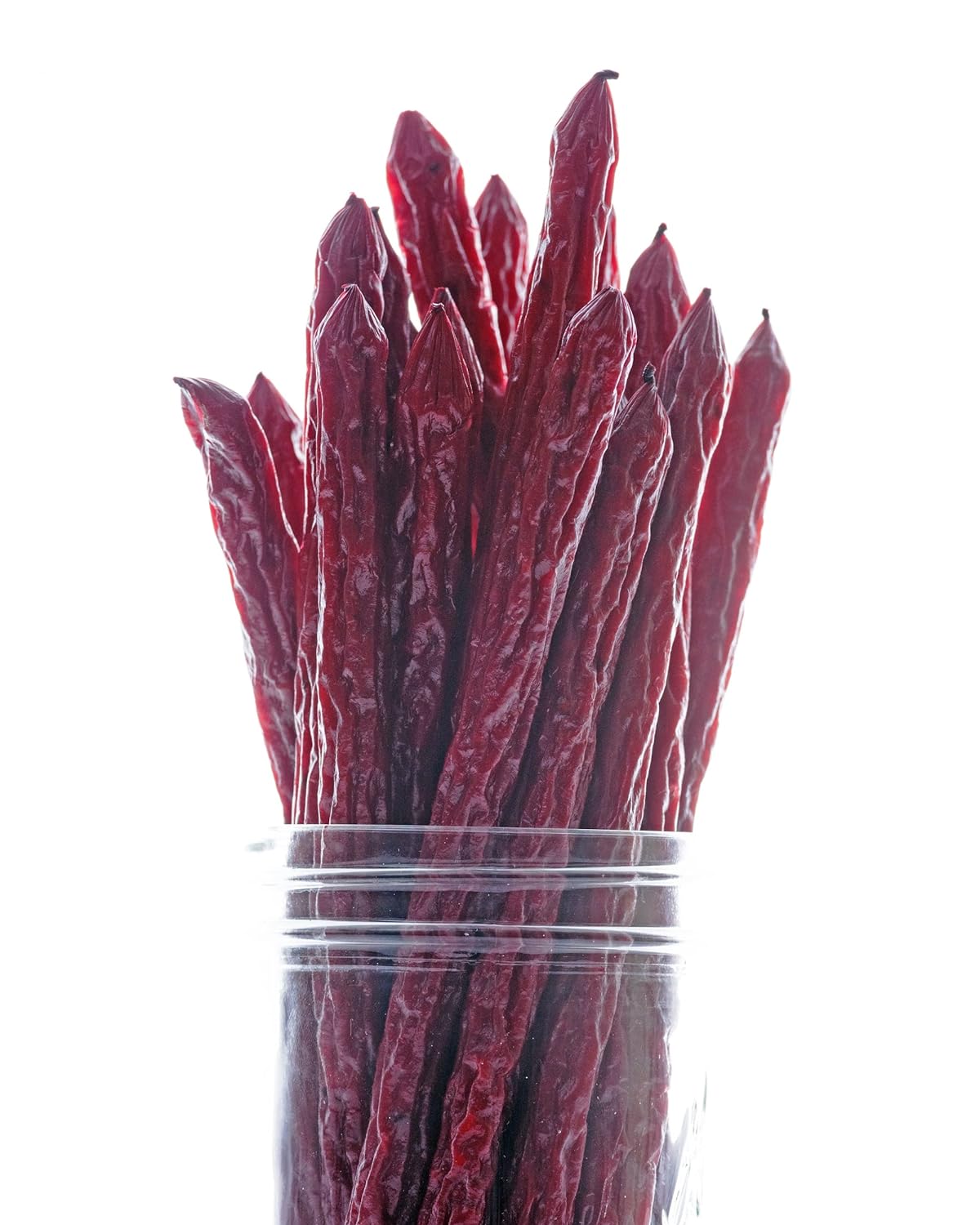The shelf life of meat sticks varies depending on a number of factors, including the ingredients used, the preservation methods employed, and the storage conditions. Generally, meat sticks are created to be a durable and long-lasting snack option, with an emphasis on both convenience and flavor. They’re often made with curing agents that work to extend their edible period while preventing the growth of harmful bacteria.

We understand that proper storage plays a significant role in the longevity of meat sticks. Typically, unopened meat sticks can last for several months when stored in a cool, dry place. Once the packaging is opened, however, it’s important to consume the product within a specified timeframe to maintain its quality and safety. Refrigeration can help prolong this period, keeping the snack sticks safe for consumption for a couple of weeks.
We also take into account the type of meat stick when discussing shelf life. For example, fermented cabrito snack sticks have specific moisture and pH levels that can influence their durability. It is crucial for consumers to pay attention to the product’s labeling, which often includes a best-by date, and adhere to manufacturers’ recommendations for optimal freshness.
Understanding Meat Sticks
Before we explore types and ingredients, it’s essential to understand that meat sticks are a popular protein-rich snack. They come in various meat types and flavors, often preserved to extend shelf life.
Types of Meat Sticks
Meat sticks can be crafted from a range of meats including beef, pork, turkey, and venison. Each type offers a distinct flavor profile and nutritional benefits.
- Beef: Rich and satisfying, beef sticks are a common choice, prized for their classic taste.
- Pork: Slightly richer than beef, pork sticks often have a robust flavor.
- Turkey: Turkey sticks are a leaner alternative, appreciated by those seeking a healthier snack option.
- Venison: For those who prefer game, venison sticks provide a unique and rich taste.
Ingredients and Preservatives
Our recipe for meat sticks typically includes a blend of seasoning and additives for flavor and preservation.
- Seasoning: Salt, herbs, and spices are meticulously chosen to enhance the meats’ natural flavors.
- Preservatives: Ingredients like sodium nitrite are added to prevent spoilage and maintain freshness.
Italics indicate the vital role of preservatives:
Without preservatives, meat sticks would have a much shorter shelf life and be more prone to contamination.
By carefully selecting ingredients, we ensure our meat sticks are not only tasty but also safe for consumption.
Storage Essentials

When preserving meat sticks, we must ensure they’re stored in optimal conditions to maintain freshness and safety.
Proper Storage Conditions
Our primary goal is to store meat sticks in a cool, dry place away from direct sunlight and moisture. These factors can accelerate spoilage and degrade the quality of the meat.
- Temperature: Ideally, keep the area at or below room temperature, around 68°F (20°C).
- Light: Store meat sticks in a dark place or in opaque packaging to protect from light degradation.
- Moisture: Dry places prevent mold growth and extend the shelf life of our product.
Refrigeration and Freezing
Refrigerating meat sticks significantly extends their shelf life. We should keep them in the fridge for short-term storage or the freezer for long-term preservation.
- Refrigerator: Stored at 40°F (4°C) or below, meat sticks can last several weeks.
- Freezer: In temperatures at 0°F (-18°C) or lower, meat sticks remain safe to consume for several months.
Packaging and Airtight Containers
Proper packaging is crucial for protecting meat sticks from contaminants and preserving their quality.
- Airtight Containers: Utilizing airtight containers can prevent exposure to air and limit bacteria growth.
- Packaging: Original or vacuum-sealed packaging maintains freshness and prevents freezer burn if freezing.
By following these guidelines, we ensure our meat sticks remain safe, delicious, and of the highest quality.
Shelf Life and Freshness

When discussing the longevity of meat sticks, two primary concerns are how long they can be safely stored and the signs that indicate they are no longer fresh. We’ll explore the factors affecting the shelf life and how to identify spoilage in meat sticks.
Shelf Life Determinants
Several factors influence the shelf life of meat sticks, including whether they are unopened or opened. Unopened meat sticks can last from several weeks to several months, largely due to packaging methods designed to reduce exposure to moisture and bacteria, which are key spoilage factors. For instance, meat sticks that have undergone a curing process and are vacuum-sealed typically have a longer shelf life due to the reduced oxygen content slowing down bacterial growth.
Temperature is another critical determinant. Meat sticks should be stored in a cool, dry place. If left in a warm area, meat sticks may spoil more rapidly as heat can accelerate the growth of bacteria leading to spoilage.
Signs of Spoilage
We must be vigilant in identifying when a meat stick has gone bad to avoid foodborne illnesses. Here are some telltale signs:
- Discoloration: Meat sticks should have a consistent color. If you notice any discoloring, particularly a dull or gray hue, it’s a warning sign.
- Mold: Visible mold growth is a clear indication that your meat sticks are no longer safe to consume.
- Slimy Texture: A fresh meat stick will have a firm texture. If it feels slimy or tacky, it is best to discard it.
- Odor: Any rancid or off smells emanating from the meat stick are signs of spoilage due to bacteria growth.
By keeping these factors and signs in mind, we can ensure that we enjoy our meat sticks while they are still fresh and avoid consuming spoiled products.
Safety and Quality Preservation

Ensuring the safety and quality of meat sticks is crucial as it directly influences their shelf life and the health of consumers. We will explore specific methods to avoid food poisoning and provide practical handling and consumption tips to maintain the texture and flavor of this popular snack option.
Avoiding Food Poisoning
Proper storage is vital to prevent the growth of bacteria that can cause food poisoning. Meat sticks should be kept in a cool, dry place before opening and refrigerated or consumed within three to five days after opening to ensure safety and maintain quality.
- Temperature: Keep unopened meat sticks at or below 40°F.
- Sealing: Use airtight containers to store opened meat sticks.
- Inspection: Regularly check for signs of spoilage such as off-odors, discoloration, or a slimy texture.
Handling and Consumption Tips
We always recommend washing your hands thoroughly before and after handling meat products to minimize health risks. When preparing meat sticks for consumption, use clean utensils and cutting boards to maintain the quality of the beef sticks, making them good for immediate enjoyment or incorporation into meals.
- Opening: Use clean scissors or a knife to open packaging.
- Serving: Slice meat sticks on a clean surface.
- Consuming: Eat meat sticks soon after slicing for optimal flavor and texture.
By following these guidelines, we can ensure the meat sticks we enjoy are not only a delightful snack option but also a safe choice for our health.
Lifespan by Storage Method

When considering how long meat sticks, particularly beef sticks, last, storage methods play a crucial role. We’ll discuss the impact of different storage environments on their shelf life to ensure optimal freshness and safety.
Pantry vs. Fridge vs. Freezer
Pantry:
In a cool, dry pantry, unopened beef sticks can last comfortably for several months due to the preservatives and drying methods used in their production process. Once opened, they should be consumed within a week for best quality.
Fridge:
To extend their freshness, we recommend you refrigerate beef sticks after opening. This practice can prolong their lifespan up to 6 months while maintaining their savory quality.
Freezer:
For long-term storage, you can freeze beef sticks. When kept in the freezer, they remain safe to consume for much longer periods. Properly packaged to prevent freezer burn, frozen beef sticks can last for several months up to a year while retaining quality, though ideally, they should be consumed within 6 months for optimal taste.
Opened vs. Unopened Meat Sticks
Unopened:
- Beef sticks typically retain their best quality for several months when stored in the pantry.
- If placed in the fridge or freezer, this duration can extend significantly.
Opened:
- Once open, it is vital to keep the meat sticks refrigerated.
- Opened beef sticks in the fridge are best if consumed within a week for a fresh experience, but can last up to 6 months.
- In the freezer, opened sticks should ideally be eaten within 6 months but will stay safe beyond that.
Keep in mind that the dates are based on optimum storage conditions and consistent refrigeration. Always check for any signs of spoilage such as an off odor, flavor, or appearance before consuming meat sticks, and when in doubt, it’s safer for us to discard them.
Frequently Asked Questions
In this section, we’ll tackle some common questions about meat stick preservation, selection, and storage. Our goal is to provide you with the information necessary to enjoy your snacks safely and deliciously.
About Consumption After Expiration
If you’re wondering whether you can eat beef sticks after their expiration date, it typically depends on how they’ve been stored. Unopened and properly stored beef sticks can sometimes be consumed a short time after the best by date, but always check for signs of spoilage like an off smell, discoloration, or mold. Spoilage will be evident and should guide your decision. Remember, shelf-stable products have different longevity than their refrigerated counterparts.
Choosing the Right Meat Sticks
Selecting the right meat sticks boils down to understanding the types of casings and preservatives used. Natural casings tend to have a shorter shelf life compared to collagen casings, which are more processed. If you prefer fewer additives, look for brands that use sodium nitrite or sodium nitrate sparingly. For those making homemade beef sticks or venison sticks, keep in mind these often lack the preservatives that extend shelf life, meaning they should be consumed more quickly or refrigerated.
Maintaining Optimal Flavor and Texture
The best way to store beef sticks to maintain flavor and texture involves keeping them in a cool, dry place before opening. Once opened, refrigeration is key. If you’ve bought in bulk, freeze to preserve their quality for a longer period. To defrost, leave them in the fridge overnight. This prevents the casing from splitting due to temperature shock. Speaking of casings, you might notice beef sticks turn white sometimes; this is often just the fats crystallizing and is generally not a cause for concern. Always store them away from direct heat to prevent any fat inside from spoiling or melting away, which compromises flavor and texture.
For long-term preservation, frozen homemade or Old Wisconsin beef sticks can last for 2-3 months. Yet, keep in mind that freezing can slightly alter the texture, especially for sticks with natural casings. When it comes to shelf-stable sticks with preservation techniques like curing, you can expect them to last longer without the need for refrigeration, but always verify the best by date and packaging instructions to be certain.

